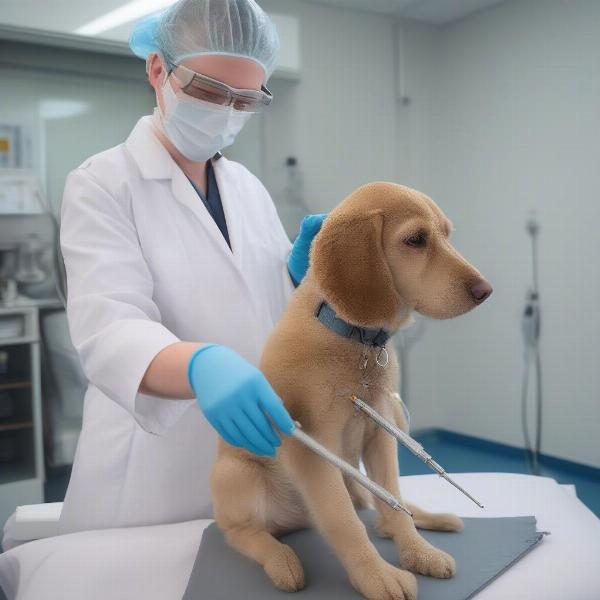TPLO (Tibial Plateau Leveling Osteotomy) surgery is a common procedure for dogs with cranial cruciate ligament (CCL) ruptures. However, it’s a significant surgery, and some pet owners explore alternatives. This article discusses non-surgical and alternative surgical options to TPLO for dogs, helping you make informed decisions about your furry friend’s care.
Understanding CCL Injuries and Why TPLO is Often Recommended
The cranial cruciate ligament (CCL) in dogs is equivalent to the anterior cruciate ligament (ACL) in humans, stabilizing the knee joint. A rupture causes pain, instability, and arthritis. TPLO is often recommended due to its high success rate in stabilizing the joint and allowing for a quicker return to function. However, factors like age, breed, activity level, and overall health influence treatment choices.
Non-Surgical Management of CCL Tears in Dogs
For partial tears or in smaller dogs, non-surgical management can be an option. This typically involves:
- Rest and Restricted Activity: Limiting movement helps reduce inflammation and allows the ligament to heal.
- Weight Management: Maintaining a healthy weight minimizes stress on the joint.
- Pain Medication and Anti-inflammatories: These help manage pain and swelling.
- Physical Therapy: Targeted exercises can strengthen supporting muscles and improve joint stability.
- Bracing and Support: Braces can provide external support and stability to the knee.
While non-surgical management can be effective in some cases, it may not be suitable for complete tears or larger, more active dogs.
Surgical Alternatives to TPLO for Dogs
Several surgical alternatives to TPLO exist, each with its pros and cons:
TightRope® CCL
This technique uses a synthetic ligament to replace the torn CCL, stabilizing the joint. It’s less invasive than TPLO but may not be as suitable for larger breeds.
Lateral Suture Stabilization
This older technique involves placing sutures outside the joint to mimic the function of the CCL. While less complex than TPLO, it has a lower success rate, especially in larger dogs.
 TightRope CCL Surgery in Dogs
TightRope CCL Surgery in Dogs
TTA (Tibial Tuberosity Advancement)
TTA alters the biomechanics of the knee joint by changing the angle of the tibial tuberosity. It’s another effective option, often compared to TPLO, with a slightly different approach to stabilization. dog tta surgery
Extracapsular Repair Techniques
These techniques involve placing a suture or implant outside the joint capsule to stabilize the knee. While less complex, they may not be as effective as TPLO or TTA, especially in active dogs.
Choosing the Right Treatment for Your Dog
The best treatment option for a CCL tear depends on several individual factors. Your veterinarian will consider your dog’s age, breed, size, activity level, overall health, and the severity of the tear. They will discuss the pros and cons of each option and help you make the most informed decision for your pet’s specific needs.
Conclusion
While TPLO is a common and effective treatment for CCL tears in dogs, alternatives are available. Non-surgical management can be suitable for some cases, and alternative surgical procedures offer varying levels of invasiveness and success rates. Consulting with your veterinarian is crucial to determine the most appropriate treatment plan for your dog’s individual needs, ensuring the best possible outcome and a return to happy, healthy activity. dog cruciate ligament surgery
FAQ
- Is TPLO surgery always necessary for CCL tears? No, not always. Non-surgical management or alternative surgical procedures can be considered depending on the individual dog’s circumstances.
- What are the risks and complications of TPLO surgery? Like any surgery, TPLO carries risks such as infection, implant failure, and complications with anesthesia. Your vet will discuss these risks with you.
- How long is the recovery period after TPLO surgery? Recovery typically takes several months, involving restricted activity, physical therapy, and gradual return to normal activity levels. knee surgery dogs
- Are there any breed predispositions to CCL tears? Yes, certain breeds, such as Rottweilers, Labradors, and Golden Retrievers, are more prone to CCL tears.
- What is the long-term prognosis for dogs after CCL surgery? With proper care and rehabilitation, most dogs have a good long-term prognosis and can return to a good quality of life. cruciate surgery dog
- How much does TPLO surgery typically cost? The cost can vary depending on location and veterinary clinic, but it can be a significant investment.
- What are the signs of a CCL tear in dogs? Common signs include lameness, limping, stiffness, swelling of the knee joint, and difficulty bearing weight on the affected leg. tta surgery dog
ILM Dog is a leading online resource for dog owners worldwide, providing expert advice on dog breeds, health, training, nutrition, grooming, and more. We are committed to helping you provide the best possible care for your canine companion. For any questions or inquiries, feel free to contact us via email at [email protected] or phone at +44 20-3965-8624. ILM Dog is your trusted partner in responsible dog ownership.